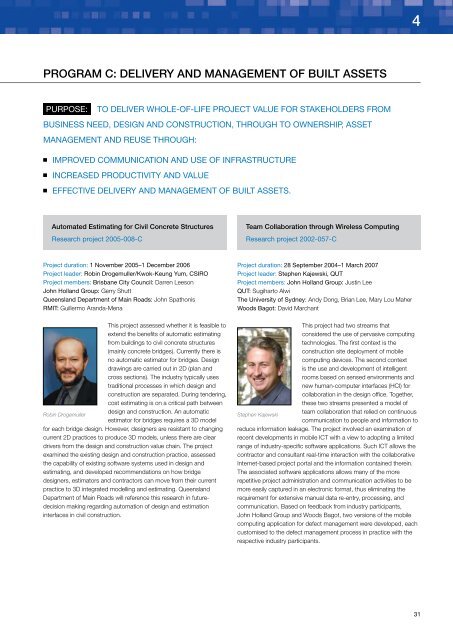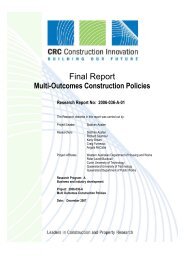2006-07 - Construction Innovation
2006-07 - Construction Innovation
2006-07 - Construction Innovation
Create successful ePaper yourself
Turn your PDF publications into a flip-book with our unique Google optimized e-Paper software.
4<br />
PROGRAM C: DELIVERY AND MANAGEMENT OF BUILT ASSETS<br />
PURPOSE:<br />
TO DELIVER WHOLE-OF-LIFE PROJECT VALUE FOR STAKEHOLDERS FROM<br />
BUSINESS NEED, DESIGN AND CONSTRUCTION, THROUGH TO OWNERSHIP, ASSET<br />
MANAGEMENT AND REUSE THROUGH:<br />
IMPROVED COMMUNICATION AND USE OF INFRASTRUCTURE<br />
INCREASED PRODUCTIVITY AND VALUE<br />
EFFECTIVE DELIVERY AND MANAGEMENT OF BUILT ASSETS.<br />
Automated Estimating for Civil Concrete Structures<br />
Research project 2005-008-C<br />
Team Collaboration through Wireless Computing<br />
Research project 2002-057-C<br />
Project duration: 1 November 2005–1 December <strong>2006</strong><br />
Project leader: Robin Drogemuller/Kwok-Keung Yum, CSIRO<br />
Project members: Brisbane City Council: Darren Leeson<br />
John Holland Group: Gerry Shutt<br />
Queensland Department of Main Roads: John Spathonis<br />
RMIT: Guillermo Aranda-Mena<br />
Project duration: 28 September 2004–1 March 20<strong>07</strong><br />
Project leader: Stephen Kajewski, QUT<br />
Project members: John Holland Group: Justin Lee<br />
QUT: Sugiharto Alwi<br />
The University of Sydney: Andy Dong, Brian Lee, Mary Lou Maher<br />
Woods Bagot: David Marchant<br />
This project assessed whether it is feasible to<br />
extend the benefits of automatic estimating<br />
from buildings to civil concrete structures<br />
(mainly concrete bridges). Currently there is<br />
no automatic estimator for bridges. Design<br />
drawings are carried out in 2D (plan and<br />
cross sections). The industry typically uses<br />
traditional processes in which design and<br />
construction are separated. During tendering,<br />
cost estimating is on a critical path between<br />
design and construction. An automatic<br />
Robin Drogemuller<br />
estimator for bridges requires a 3D model<br />
for each bridge design. However, designers are resistant to changing<br />
current 2D practices to produce 3D models, unless there are clear<br />
drivers from the design and construction value chain. The project<br />
examined the existing design and construction practice, assessed<br />
the capability of existing software systems used in design and<br />
estimating, and developed recommendations on how bridge<br />
designers, estimators and contractors can move from their current<br />
practice to 3D integrated modelling and estimating. Queensland<br />
Department of Main Roads will reference this research in futuredecision<br />
making regarding automation of design and estimation<br />
interfaces in civil construction.<br />
This project had two streams that<br />
considered the use of pervasive computing<br />
technologies. The first context is the<br />
construction site deployment of mobile<br />
computing devices. The second context<br />
is the use and development of intelligent<br />
rooms based on sensed environments and<br />
new human-computer interfaces (HCI) for<br />
collaboration in the design office. Together,<br />
these two streams presented a model of<br />
team collaboration that relied on continuous<br />
Stephen Kajewski<br />
communication to people and information to<br />
reduce information leakage. The project involved an examination of<br />
recent developments in mobile ICT with a view to adopting a limited<br />
range of industry-specific software applications. Such ICT allows the<br />
contractor and consultant real-time interaction with the collaborative<br />
Internet-based project portal and the information contained therein.<br />
The associated software applications allows many of the more<br />
repetitive project administration and communication activities to be<br />
more easily captured in an electronic format, thus eliminating the<br />
requirement for extensive manual data re-entry, processing, and<br />
communication. Based on feedback from industry participants,<br />
John Holland Group and Woods Bagot, two versions of the mobile<br />
computing application for defect management were developed, each<br />
customised to the defect management process in practice with the<br />
respective industry participants.<br />
31

















